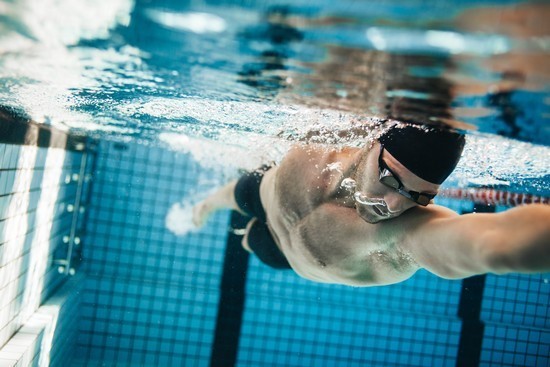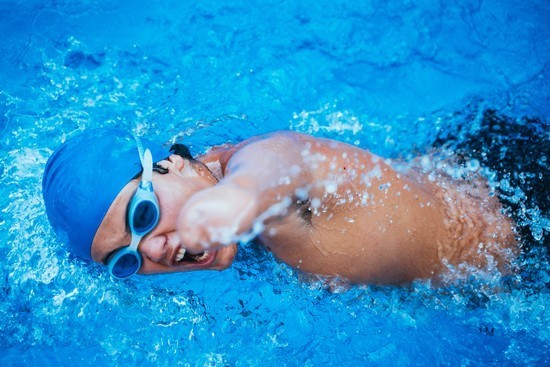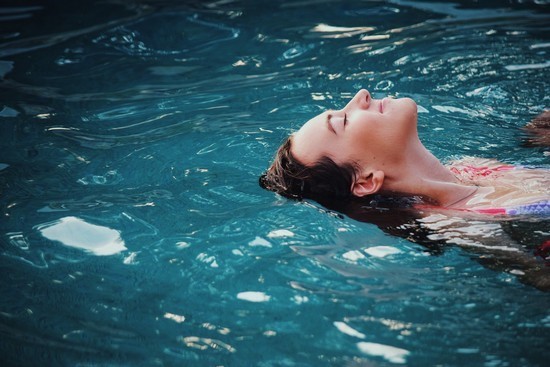Swimming is one of the more unique forms of exercise that is
as innate as running — stone-age cave paintings depict humans swimming and
babies are born with an innate swimming reflex. Modern competitive swimming has
been one of the world’s most popular sports since the 1830s. But you do not have
to swim competitively to reap the positive health benefits that swimming can
offer.
اضافة اعلان
Swimming is both a sport and a recreational
activity. Whether at the beach or in an Olympic pool, swimming is an activity
almost anyone can take part in. Competitively, the sport consists of four
different stroke styles: freestyle, backstroke, breaststroke, and butterfly.
One of the most decorated Olympians of all time, US swimmer Michael Phelps, is
a master of all four. For beginners, the breaststroke, which is the easiest and
slowest, is usually the one you learn first. For those seeking toned and built
muscles, the butterfly stroke is the most effective. There are a lot of online
materials that can help you learn how to perform each technique. While learning
different styles is not a requirement, it can be an exciting challenge to keep
you interested in the sport.
Health benefits
Swimming can at the very least provide the same basic cardio exercise
as walking, but it brings with it benefits that walking does not. A study from
the University of South Carolina with a sample of over 40,000 participants
found that swimmers were at a 53 percent, 50 percent, and 49 percent lower risk
of death by any cause than men who were inactive, walkers, or runners,
respectively. Many of the benefits of swimming stem from the fact that there is
greater resistance in water than on land. Compared to cardiovascular exercise
on land, swimming requires more force per movement. Therefore, swimming is more
effective at building endurance and muscle capacity quickly. Additionally, a
study from Harvard revealed that swimming at a slow pace burns around 200–250
calories per 30 minutes, while a vigorous pace would burn upwards of 350
calories, which is almost double the amount of calories of walking or light
jogging.

While high impact
cardio exercises such as running can severely damage the joints over time,
swimming can actually make joints more flexible and aid in the recovery
process. In a study of elderly women’s cardiovascular response to different
forms of exercise, results found that they were able to exercise for longer and
with less muscle and joint pain in water than on land. Additionally, swimming
has been shown to not only relieve the pain of joint conditions such as
arthritis but also restore some function and mobility as well. Another study
attempted to develop a form of water exercises known as hydrotherapy for
rheumatoid arthritis patients. It was found that all patients improved both
physically and emotionally, and showed improvements in joint tenderness and
range of movement as well as a decrease in the belief that the pain was out of
their control. Moreover, when compared to other forms of exercise such as
seated immersion, land exercise, or progressive relaxation, hydrotherapy produced
the greatest improvements.
Other than the benefits of swimming as an exercise,
researchers have also investigated immersion in water as a form of
cardiotherapy. A study of the cardiac response of elderly patients with chronic
heart failure to immersion in a temperature-controlled swimming pool recorded
an overall improvement of capacity and function of the heart. Another study of
immersion therapy found that for patients with fibromyalgia, swimming is
effective in enhancing both physical and mental health. Participants saw
improvements in functional capacity for walking, stair-climbing, stiffness,
anxiety, depression, and balance. Even without moving, being partially
submerged helped, especially for those with preexisting medical conditions.

Water-based therapies
and exercises can benefit those already in good health. A study of pregnant
women found a wide range of physical and psychological effects for those who
participated in water immersion and exercise. Not only was there an improvement
of mood and mental well-being, but it proved valuable for the prevention and
treatment of pregnancy related illnesses such as gestational diabetes (i.e., a
form of diabetes caused by pregnancy). Additionally, a study of the effect of
water exercise on postmenopausal women’s bone density concluded a significantly
positive result, leading to healthier bones. Along with the proven positive
effect on cardiac health of elderly, a 2007 study from an elderly day service
facility showed that water exercise significantly improved the health-related
quality of life and ease of activities of daily living for the frail seniors.
How to swim safely
An estimated 236,000 people drown every year; it is the third leading
cause of unintentional death worldwide. Although there are risks involved, when
performed safely these risks can be minimized. Some important recommendations
for safety include never swimming alone, having young or inexperienced swimmers
wear life jackets, keeping a first aid kit nearby, and following the beach or
pool safety rules that prohibit running, diving, and pushing others. Learning
to swim from a young age is also an effective way to prevent accidental deaths
by drowning. The Children’s Hospital of Pittsburgh recommends all children aged
four and older to enroll in a swimming program.

Focusing on
swimming with proper form is important to prevent injury. Despite being
overlooked by many beginners, coordinating your inhales and exhales with your
head position in swimming strokes is one of the most essential elements of
proper swimming form. Many swimming coaches recommend humming while exhaling to
slow breathing and set a steady pace. If you try to lift your head out of the
water, you will be forcing your shoulder or torso to go deeper into the water,
which will negatively impact your swim speed and take more of your energy.
Practice turning your head without lowering other parts of your body to
compensate. Although beginners often attempt to rely mostly on the upper body,
the lower body is just as, if not more, important. For proper kicking form,
your legs should be straight, stiff, and streamlined directly behind the body.
However, when mimicking the flippers of aquatic animals, your feet should
remain flexible and loose. Additionally, rotating your hips is essential for an
effective stroke. Positioned in the middle of the body, the hips are the clear
coordinator of the movement and transfer of momentum between the upper and
lower body. Allowing your hips to rotate as you lift your arms for each stroke
will allow for a more seamless distribution of power.
Swimming in Jordan
Swimming has always been a beloved activity in Jordan. Whether at Amman
Waves, Sports City, or Aqaba, many Jordanians have no shortage of childhood
memories in the water. Jordan is currently experiencing what the Olympics
committee refers to as the “golden generation of Jordanian swimmers”. Athletes
like Baqlah Khader and his older sister Talita are making history for Jordan,
both having qualified for the Olympics and setting records the likes of which
our country has never seen. Organizations like Swim Jordan are improving
inclusivity and accessibility for all Jordanians wishing to be competitive
swimmers or even just have a fun swim at the pool. Swim Jordan encourages
swimming as a confidence building and healthy environment for growth for people
of all ages, genders, and abilities (both physical and mental).
Read more Health
Jordan News








